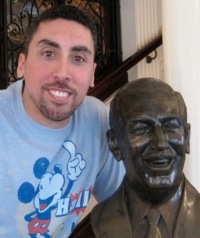As Fantasia is a feature film made up of eight animated segments, we're dedicating separate posts throughout the month for each part... the first being "The Sorcerer's Apprentice":
 After the phenomenal success of Snow White and the Seven Dwarfs, Disney utilized its earnings to construct a new, state-of-the-art studio on Buena Vista Street in Burbank, California. One of the first two animated features completed there was Bambi. The other, a series of animated sequences set to classical music, was known early on as The Concert Feature.
After the phenomenal success of Snow White and the Seven Dwarfs, Disney utilized its earnings to construct a new, state-of-the-art studio on Buena Vista Street in Burbank, California. One of the first two animated features completed there was Bambi. The other, a series of animated sequences set to classical music, was known early on as The Concert Feature.
In 1937, several months before the premiere of Snow White, Walt expressed a desire to set animation to classical music. He had already enjoyed success with his music-driven Silly Symphonies series. “Music has always played a very important part since sound came to the cartoon,” Walt said. He chose The Sorcerer’s Apprentice, an 1897 concert piece by French composer Paul Dukas, which was based on a 1797 poem by Johann Wolfgang von Goethe, which itself was based on a 2nd century tale by the Greek satirist Lucian. Its story revolves around an apprentice of a great sorcerer who has grown tired from repetitive manual labor, and decides to automate his chores with a little help from his departed master’s hat. When the apprentice falls asleep, however, he awakens to find himself in a bit of a predicament.
The Disney story team began planning Apprentice around the recordings of acclaimed Italian conductor Arturo Toscanini. That changed in 1938 after a chance encounter Walt had with the great conductor Leopold Stokowski (a fixture in Hollywood at the time, providing his services on a variety of films). “I first met Walt Disney in a restaurant,” Stokowski outlined in a letter he wrote in 1967. “I was alone having dinner at a table near him and he called across to me, ‘Why don’t we sit together?’ Then he began to tell me he was interested in Dukas’s The Sorcerer’s Apprentice as a possible short, and did I like the music. I said I liked it very much and would be happy to cooperate with him.”
 Apprentice was originally planned as its own short film. No dialogue, no subtitles, just the apprentice and his co-stars moving to the Dukas score. Mickey, however, was not everyone’s first choice to play the apprentice. There was some early talk of featuring Dopey in the starring role, but Walt was not interested in using any characters from Snow White. Stokowski himself suggested to Walt that they create an entirely new personality to play the apprentice, a suggestion Walt promptly ignored. Walt wanted to cast Mickey Mouse, who given his mischievous nature yet universal appeal made him the logical choice. Walt even called upon “Mickey expert” Fred Moore to redesign the mouse, to allow a greater degree of expression. The end result entailed a slight “humanizing” of Mickey, with more definition in his face, and pupils for his eyes.
Apprentice was originally planned as its own short film. No dialogue, no subtitles, just the apprentice and his co-stars moving to the Dukas score. Mickey, however, was not everyone’s first choice to play the apprentice. There was some early talk of featuring Dopey in the starring role, but Walt was not interested in using any characters from Snow White. Stokowski himself suggested to Walt that they create an entirely new personality to play the apprentice, a suggestion Walt promptly ignored. Walt wanted to cast Mickey Mouse, who given his mischievous nature yet universal appeal made him the logical choice. Walt even called upon “Mickey expert” Fred Moore to redesign the mouse, to allow a greater degree of expression. The end result entailed a slight “humanizing” of Mickey, with more definition in his face, and pupils for his eyes.
A Stokowski suggestion Walt did like was that they expand on his idea, and create a whole series of shorts set to classical music. The conductor played other works for Walt, and the two began to verbalize their interpretations to one another. Their respective visions varied from degrees of brightness, to which color dominated the landscape. Soon after that meeting, Walt hired Deems Taylor, a well-known musicologist. Taylor and Stokowski sat in on story sessions with Walt and his people, and with Walt being the ultimate story man, ideas for this unprecedented work in animation became grander and more innovative. So innovative in fact, the film itself was responsible for the creation of an entirely new theatrical sound system (known then as Fantasound). Ultimately, the project grew into what would be Walt Disney Studios’ longest animated feature (still to this day), and the working title The Concert Feature was dropped in favor of an alternate working title: Fantasia.

Keith Gluck is a WDFM volunteer, writer/editor for thedisneyproject.com, a Disney fan site. His Disney life started early, visiting Disneyland before turning one, and writing his very first book report on a Walt Disney biography for kids.
In celebration of National Book Week, Disney author and historian J.B. Kaufman will discuss Disney’s Big Little Books on Saturday August 25 at 3pm here at The Walt Disney Family Museum. In discussing how these little gems were assembled, Kaufman will use clips from early Disney films and comic strips to show how original stories often went through interesting adaptations as they were reworked to fit the small book medium.
[Images above: Concept art from "The Sorcerer's Apprentice". Courtesy The Walt Disney Company, ©Disney.]
